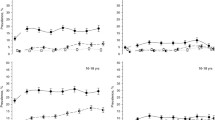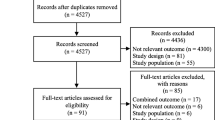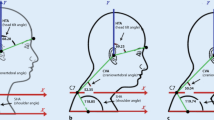Abstract
Body height is an alleged risk factor for low back pain in adulthood, but its importance regarding non-specific neck pain is obscure during childhood and adolescence. We studied anthropometric measurements for their associations with the incidence of neck pain in a population study of 430 children who were examined five times: at the age 11–14 and 22 years. Body height and weight and the degrees of trunk asymmetry, thoracic kyphosis and lumbar lordosis were measured at every examination. The history of neck pain was obtained by a structured questionnaire at the final examination. The incidence of neck pain was defined as pain occurring in eight or more days during the past year. Short stature at 11 years of age predicted the incidence of neck pain. Adjusted for sex, the odds ratio (with 95% confidence interval) per an increment of one standard deviation of body height was 0.78 (0.62–0.97). At 22 years of age there was accordingly an inverse association between current body height and neck pain history, the odds ratio being 0.62 (0.45–0.86). Male sex was found to protect against neck pain; the odds ratio was 0.28 (0.18–0.44). Anthropometric measurements other than body height were not found to predict neck pain. The role of anthropometric factors in the development of neck pain at young adulthood seems only modest. Short stature may be a risk determinant of neck pain.
Similar content being viewed by others
References
Balague’ F, Dutoit G, Waldburger M (1988) Low back pain in schoolchildren. Scand J Rehabil Med 20:175–179
Fairbank J, Pynsent P, van Poortvliet J, Phillips H (1984) Influence of anthropometric factors and joint laxity in the incidence of adolescent back pain. Spine 9(5):461–464
Hakala P, Rimpelä A, Salminen J,Virtanen S, Rimpelä M (2002) Back, neck and shoulder pain in Finnish adolescents: national cross sectional surveys. Br Med J 325:743
Heliövaara M, Mäkelä M, Knekt P, Impivaara O, Aromaa A (1991) Determinants of sciatica and low back pain. Spine 16(6):608–614
Lindqvist C, Signell H, Wasz-Höckert C (1962) Synpunkter påhållningsfel hos barn (in swedish). Finska Läkaresällskapets Handlingar 106:146–157
Nissinen M (1995) Spinal posture during pubertal growth. Acta Pediatr 84:308–312
Nissinen M, Heliövaara M, Seitsamo J, Alaranta H, Poussa M (1994) Anthropometric measurements and the incidence of low-back pain in a cohort of pubertal children. Spine 19(12):1367–1370
Nissinen MJ, Heliövaara MM, Seitsamo JT, Könönen MH, Hurmerinta KA, Poussa MS (2000) Development of trunk asymmetry in a cohort of children ages 11 to 22 years. Spine 25(5):570–574
Nissinen M, Heliövaara M, Seitsamo J, Poussa M (1993) Trunk asymmetry, posture,growth and risk of scoliosis a three-year follow-up study of Finnish prepubertal school children. Spine 18(1):8–13
Nissinen M, Heliövaara M, Ylikoski M, Poussa M (1993) Trunk asymmetry and screening for scoliosis: a longitudinal cohort study of puberal school children. Acta Pediatr 82:77–82
Nissinen M, Heliövaara M, Ylikoski M, Poussa M (1993) Trunk asymmetry and screening for scoliosis: a longitudinal cohort study of puberal school children. Acta Pediatr 82:77–82
Poussa M, Heliövaara M, Seitsamo J, Könönen M, Hurmerinta K, Nissinen M (2005) Anthropometric measurements and growth as predictors of low back pain: a cohort of study of children followed up from the age of 11 to 22 years. Eur Spin J 14:595–598
Poussa M, Heliövaara M, Seitsamo J, Könönen M, Hurmerinta K, Nissinen M (2005) Development of spinal posture in a cohort of children from the age of 11 to 22 years. Eur Spin J. DOI 10.1007/s 00586-004-0701-9
Takala E-P, Viikari-Juntura E (1991) Muscular activity in simulated light work among subjects with frequent neck-shoulder pain. Int J Ind Ergon 8:157–164
Ulph F, Betts P, Mulligan J, Stratford RJ (2004) Personality functioning: the influence of stature. Arch Dis Child 89:17–21
Zimet G, Owens R, Dahms W, Cutler M, Litvene M, Cuttler L (1997) Psychosocial outcome of children evaluated for short stature. Arch Pediatr Adolesc Med 151(10):1017–1023
Author information
Authors and Affiliations
Corresponding author
Rights and permissions
About this article
Cite this article
Poussa, M.S., Heliövaara, M.M., Seitsamo, J.T. et al. Predictors of neck pain: a cohort study of children followed up from the age of 11 to 22 years. Eur Spine J 14, 1033–1036 (2005). https://doi.org/10.1007/s00586-005-0978-3
Received:
Revised:
Accepted:
Published:
Issue Date:
DOI: https://doi.org/10.1007/s00586-005-0978-3




